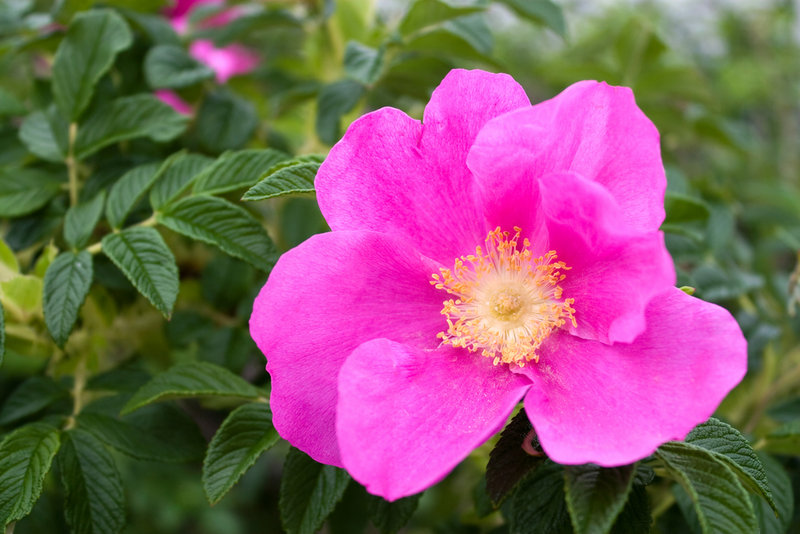Roses bloomed late in the gardens this season, but by now it’s time to get them ready for the winter.
“The weather hasn’t been that cold so far,” said Jerry Morin, the last president of the Maine Rose Society, when I spoke to him about 10 days ago. “When it starts getting down to about 20 degrees, you want to start mounding them by then.”
Morin, by the way, is the last president of the society because the group has disbanded. He said the society was just unable to attract new members. A sign of the times for all clubs rather than a lack of interest in roses, but it is sad to see the club gone.
But back to the roses.
With hybrid tea roses — the most delicate kind — Morin recommends cutting the roses back to about 18 inches. After you put the soil on, you should tamp it down a bit. He then sprays them with a fungicide, which not everyone does, and mounds soil up about 6 to 10 inches high around the stems.
“Then I put some mulch on top of that,” Morin said. “It can be straw, leaves, pine branches — just about anything to keep the soil warm.”
Morin does not use the Styrofoam rose covers that they sell at a wide variety of garden centers, although he knows a lot of serious rose growers who do. Early in our gardening career, Nancy and I used the covers, but gave up on them because they kept blowing away. And if you do use them, you’ll want to make sure the ground is pretty well frozen before you put them on.
If you don’t use the rose covers, Morin finds that the April rains will usually wash away the soil that he mounds up around his roses, so he doesn’t have the extra step of removing the soil.
Morin has a couple of other tips that he uses to make sure roses go through the winter well, but you should have started following them back in the middle of the summer.
“You don’t want to fertilize after June 31,” he said. The fertilizer will promote late-season growth, which will be tender going into the cold weather.
One year, he had some bagged fertilized soil that he used for mounding his roses, and the fertilizer promoted winter growth. That did not turn out well.
Also, when it gets to be late summer — late August or early September — stop dead-heading your roses so they can develop rose hips. Morin and I both like the looks of the hips, a red fruit, but that is not the only reason to let them grow.
“Developing hips seems to make the plant’s branches a little bit stronger,” Morin said.
For rugosa roses and the newer, tougher roses such as the Knockout series, you don’t have to worry as much. They are so strong, they could stand just about anything.
I do get a lot of questions about pruning rugosa roses, especially when people have a mass of them as a hedge. If you let the rugosas go, the hedge will sometimes get 10 feet high, which will provide some privacy but also block the views.
My method of cutting back rugosas is to cut out a few of the larger rose stems pretty close to the ground, just to thin everything out a little bit. And then I cut the rest of the bushes back to about the height that particular hedge should be. If you cut them back to about a foot tall in the fall, the next growing season, they will produce a lot of blooms and grow to about 4 feet tall. If you cut them back to about 4 feet, they will grow to about 6 feet the next season.
The Knockout roses don’t grow as quickly as the rugosas, so I haven’t pruned those as hard. They haven’t been planted in Maine as long as rugosas, so maybe when they get a bit older they will need a little bit of pruning — but they haven’t yet.
POWERSCOURT ADDENDUM
After last week’s column appeared, I got an email immediately from Aoife O’Driscoll of the Powerscourt marketing department, thanking me for writing the column.
She said it is good to get feedback on the labeling, “and we will continue to expand our labeling of key plants and trees. We are hoping to produce a new brochure on trees in the near future which will help visitors enjoy the gardens even more.”
And she said the Japanese garden is “a Victorian idea of a Japanese garden rather than a traditional Japanese garden but I understand where you are coming from.”
It was good to get feedback from her.
Tom Atwell has been writing the Maine Gardener column since 2004. He is a freelance writer from Cape Elizabeth and can be contacted at 767-2297 or at: tomatwell@me.com
Send questions/comments to the editors.



Success. Please wait for the page to reload. If the page does not reload within 5 seconds, please refresh the page.
Enter your email and password to access comments.
Hi, to comment on stories you must . This profile is in addition to your subscription and website login.
Already have a commenting profile? .
Invalid username/password.
Please check your email to confirm and complete your registration.
Only subscribers are eligible to post comments. Please subscribe or login first for digital access. Here’s why.
Use the form below to reset your password. When you've submitted your account email, we will send an email with a reset code.